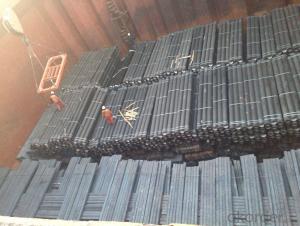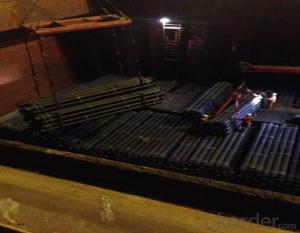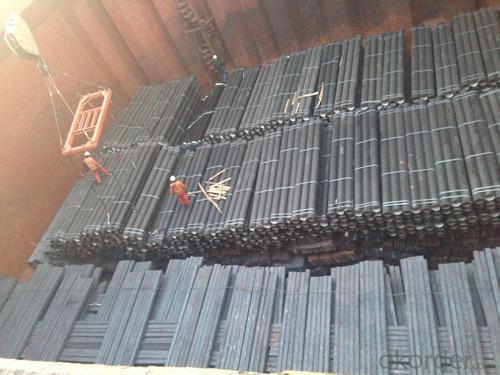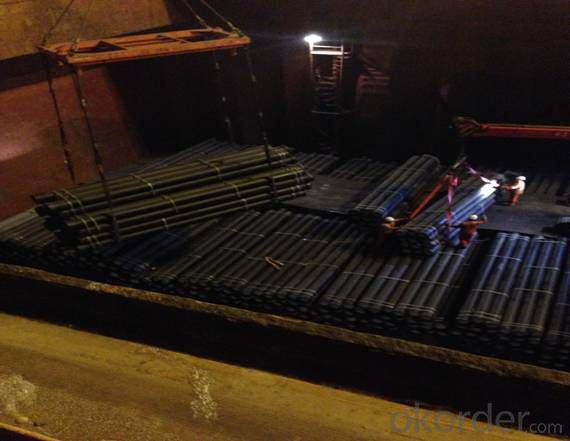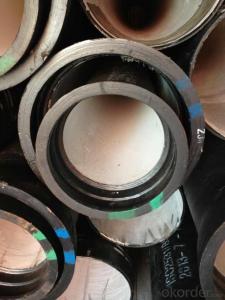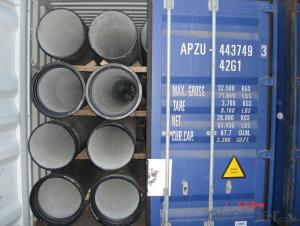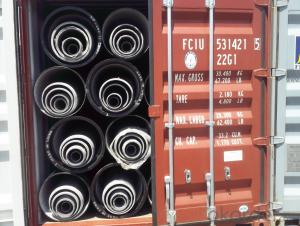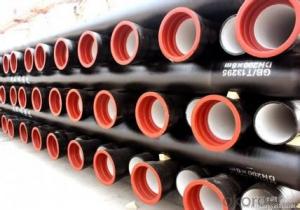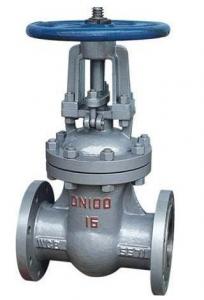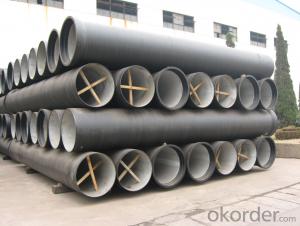DUCTILE IRON PIPE C Class DN350
- Loading Port:
- China Main Port
- Payment Terms:
- TT OR LC
- Min Order Qty:
- -
- Supply Capability:
- -
OKorder Service Pledge
OKorder Financial Service
You Might Also Like
Ductile Iron Cast Pipe is without any defects compare with tradition casting tech, which has many advantages particularly as follow:
(1) High density. In the "vertical upward casting" process, the melt iron of centre liquid column in center crystallizer is continuously feeding for volume shrinkage caused by condensation tube at outer circumference , which lead to be free of shrinkage porosity.
(2) High purity. When melt iron pouring, the mixed impurities such as gas, dross, sand grain which are lighter than melt iron could be eliminated at furnace mouth, its impossible to enter into the crystallizer through the channel, so the melt iron into the crystallizer is very pure.
(3) Strength with toughness. The cooling speed provided by continuous crystallizer is 30 times than sand casting and 5 times than centrifugal casting, and doesn't produce white iron, the eutectic cell volume of continuous cast iron is one eighth to one tenth compare with traditional cast iron. The density of graphite nodule in ductile iron can reach 300-700 pcs/mm2. Therefore, all reason above improve the strength and toughness of continuous cast iron.
(4) Free machining. The high speed cooling make the hardening phase (such as boride, steadite) not appear like reticular, massive or thick, but diffuse like fish bone and pane in shape, moreover, there are tiny graphite flakes inlaid hardening phase. It's free machining in BrinellHardness the range of 250-300HB. However, the Brinell Hardness of 250 is top limit to common metal materials.
(5) Uniform composition of tube wall. The convection mixing of liquid column caused by marching type drawing in crystallizer make the composition of tube wall well-distributed, and concentration gradient very little.
(6) High productivity. To the wall thickness of tube under 10mm, the speed of continuous casting is 1 meter/min, to the wall thickness of tube under 20mm, the speed of continuous casting is 0.5 meter/min, which is high efficiency that centrifugal or other casting tech couldn't reach.
- Q: What is the maximum operating pressure for ductile iron pipes?
- The maximum operating pressure of ductile iron pipes may vary based on factors like pipe diameter, wall thickness, and the specific usage. Nonetheless, typically, ductile iron pipes are engineered to endure pressures of up to 350 psi (pounds per square inch), and occasionally even higher. It is worth highlighting that to ascertain the precise maximum operating pressure for a specific ductile iron pipe system, one should refer to local regulations, engineering standards, and manufacturer specifications.
- Q: How does ductile iron pipe perform in areas with high traffic loads?
- Ductile iron pipe performs exceptionally well in areas with high traffic loads. Due to its superior strength and durability, it is highly capable of handling heavy loads and withstanding the impact caused by vehicular traffic. Ductile iron pipes have a high resistance to bending and cracking, making them ideal for applications in roadways, highways, and other high traffic areas. The high strength of ductile iron pipe allows it to distribute the weight and pressure exerted by heavy traffic loads more effectively, reducing the risk of deformation or failure. This makes it a reliable choice for transporting water, sewage, and other fluids in areas where heavy vehicles are commonly present. Additionally, ductile iron pipe has excellent corrosion resistance, which further enhances its performance in high traffic areas. It can withstand exposure to various environmental conditions, including moisture, chemicals, and abrasion, without compromising its structural integrity. This makes it a long-lasting and cost-effective solution, as it requires minimal maintenance and has a long service life. Furthermore, ductile iron pipe's smooth internal surface minimizes friction and allows for efficient flow of liquids, reducing energy consumption and maximizing the pipe's hydraulic capacity. This is particularly beneficial in areas with high traffic loads, where the demand for water or wastewater transportation is often greater. In summary, ductile iron pipe is a reliable and durable choice for areas with high traffic loads. Its strength, resistance to bending and cracking, corrosion resistance, and efficient flow characteristics make it an excellent option for transportation systems in roadways, highways, and other heavily trafficked areas.
- Q: Can ductile iron pipe be used for bridge crossings?
- Yes, ductile iron pipe can be used for bridge crossings. Ductile iron pipe is known for its strength, durability, and flexibility, making it suitable for various applications, including bridge crossings. Its high tensile strength allows it to withstand heavy loads and vibrations, making it ideal for supporting bridges and handling the weight of traffic. Additionally, ductile iron pipe's flexibility allows it to absorb movements and deformations caused by temperature changes, settling, and other factors, reducing the risk of structural damage and ensuring the longevity of the bridge crossing. Furthermore, ductile iron pipe is resistant to corrosion, making it a reliable choice for bridge crossings where exposure to moisture, chemicals, and other corrosive elements is common. Overall, ductile iron pipe's properties make it a suitable and reliable material for bridge crossings.
- Q: Can ductile iron pipes be used for pressure reducing stations?
- Yes, ductile iron pipes can be used for pressure reducing stations. Ductile iron pipes have high strength and durability, making them suitable for handling high-pressure systems. Additionally, their corrosion resistance properties make them a reliable choice for long-term use in pressure reducing stations.
- Q: What are the typical lengths of ductile iron pipes?
- The specific project requirements and industry standards play a significant role in determining the typical lengths of ductile iron pipes. Generally, ductile iron pipes are commonly available in lengths ranging from 18 feet (5.5 meters) to 20 feet (6 meters). These lengths are well-suited for a variety of applications including water distribution, wastewater systems, and industrial pipelines. It is worth mentioning that custom lengths can also be produced to fulfill specific project requirements.
- Q: Are ductile iron pipes resistant to hydrogen sulfide corrosion?
- Yes, ductile iron pipes are generally resistant to hydrogen sulfide corrosion. Ductile iron is a type of cast iron that has been treated with magnesium to create a more flexible and durable material. This treatment significantly enhances its resistance to corrosion, including corrosion caused by hydrogen sulfide. The magnesium in the ductile iron forms a protective layer on the surface, preventing the penetration of hydrogen sulfide and other corrosive agents. However, it is important to note that the resistance of ductile iron pipes to hydrogen sulfide corrosion can still be influenced by factors such as the concentration and duration of exposure to the corrosive environment. Therefore, proper maintenance, regular inspection, and appropriate protective measures should still be implemented to ensure the long-term durability and performance of ductile iron pipes in the presence of hydrogen sulfide.
- Q: What are the typical joint restraint requirements for ductile iron pipes in seismic zones?
- In seismic zones, the typical joint restraint requirements for ductile iron pipes are designed to ensure the structural integrity and prevent displacement or separation of the pipes during seismic events. These requirements are crucial to maintain the reliability and functionality of the pipeline system. One common joint restraint requirement for ductile iron pipes in seismic zones is the use of flexible or mechanical joint systems. Flexible joints, such as rubber gasket joints, can absorb and accommodate the movement caused by seismic activity. These joints allow for axial movement, angular deflection, and expansion/contraction of the pipes, reducing the risk of pipe failure or damage. Another important requirement is the use of adequate anchoring systems. This involves securing the pipes to the surrounding structures or embedding them in concrete thrust blocks to prevent excessive movement or displacement during seismic events. Anchoring systems help distribute the forces generated by the earthquake and minimize the risk of pipe separation or breaking. Additionally, seismic design standards often require the use of seismic restraints, such as seismic joint restraints or bracing systems, to further enhance the stability and integrity of the ductile iron pipes. These restraints are designed to limit the movement of the pipes in specific directions, reducing the potential for damage and maintaining the overall system performance. It is important to note that the specific joint restraint requirements for ductile iron pipes in seismic zones may vary depending on local building codes, seismic activity levels, and engineering considerations. It is crucial to consult the relevant regulations and work with experienced professionals in the design and installation process to ensure compliance with the necessary requirements for seismic resistance.
- Q: How can the cast iron pipe be connected?
- Drain pipe or water supply pipe?. The drainage tube as stated on the first floor, water supply pipe of T type and K type and S type, currently dominated by T, a lot of Xinxing Pipes as well, when connecting with T type rubber ring socket socket into the brand, after inserted with oil. The installation team is generally safe.
- Q: What are the advantages of using ductile iron pipe over HDPE pipe?
- There are several advantages of using ductile iron pipe over HDPE pipe. Firstly, ductile iron pipe is known for its high strength and durability. It is able to withstand higher pressure and is less likely to leak or burst compared to HDPE pipe. This makes ductile iron pipe a reliable choice for applications where high-pressure water or gas transmission is required, such as in municipal water supply systems or industrial piping networks. Secondly, ductile iron pipe has a longer lifespan compared to HDPE pipe. It is highly resistant to corrosion and can last for several decades, even under harsh environmental conditions. This reduces the need for frequent replacements, resulting in cost savings over time. Moreover, ductile iron pipe has excellent fire resistance properties. It can withstand high temperatures without compromising its structural integrity. This makes it a reliable choice for applications where fire safety is a concern, such as in fire hydrant systems or sprinkler systems. Additionally, ductile iron pipe is known for its superior flow characteristics. Its smooth inner surface reduces friction loss, allowing for efficient and consistent flow of fluids. This is particularly important in applications where maximum flow capacity is required, such as in water distribution systems or wastewater treatment plants. Furthermore, ductile iron pipe is highly recyclable. It can be melted down and reused to manufacture new pipes, reducing the environmental impact and promoting sustainability. In conclusion, the advantages of using ductile iron pipe over HDPE pipe include its high strength and durability, longer lifespan, fire resistance, superior flow characteristics, and recyclability. These factors make ductile iron pipe a preferred choice for various applications, especially those that require high-pressure transmission, longevity, fire safety, efficient flow, and environmental sustainability.
- Q: How do ductile iron pipes handle concentrated loads?
- Ductile iron pipes are designed specifically to effectively handle concentrated loads. Their unique composition and manufacturing process give them excellent strength and durability, making them highly resistant to cracking or breaking under heavy loads. One of the main features of ductile iron pipes is their high tensile strength, allowing them to withstand concentrated loads without deforming. During the production process, small amounts of magnesium are added to cast iron, transforming the brittle graphite flakes into nodular graphite. This modification greatly enhances the material's strength and ductility, enabling it to handle concentrated loads more effectively. Furthermore, ductile iron pipes have a high modulus of elasticity, meaning they can deform elastically under a load and then return to their original shape once the load is removed. This property allows the pipes to evenly distribute the concentrated load along their entire length, reducing stress concentrations and minimizing the risk of fractures or failures. Additionally, ductile iron pipes have a thick and robust wall thickness, ensuring exceptional structural integrity. This thickness enables the pipes to bear significant loads and withstand pressure variations without compromising their overall performance. In conclusion, ductile iron pipes are engineered specifically to handle concentrated loads due to their high tensile strength, elastic deformation capabilities, and thick wall thickness. These characteristics make them a reliable choice for a variety of applications, including water and wastewater systems, as they can withstand external forces without compromising their structural integrity.
Send your message to us
DUCTILE IRON PIPE C Class DN350
- Loading Port:
- China Main Port
- Payment Terms:
- TT OR LC
- Min Order Qty:
- -
- Supply Capability:
- -
OKorder Service Pledge
OKorder Financial Service
Similar products
Hot products
Hot Searches
Related keywords
